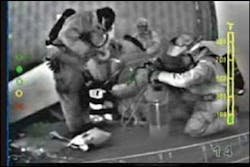Twelve months ago, this column addressed the topic of search and rescue. The training tips and ideas concentrated on searching for civilian victims; this month, we concentrate on finding firefighters.
The development, planning, training and standby use of rapid intervention teams (RITs) has increased dramatically in recent years. Proper RIT planning and training includes determining what tools should be available to the RIT. One of these tools is the thermal imager (TI).
Essentials
The January issue of Firehouse® Magazine included an article about a trapped Los Angeles County firefighter who was successfully located and evacuated with the assistance of a TI. Background noise and smoke prevented the RIT from hearing the firefighter’s personal alert safety system (PASS) device or seeing his handlight. The article indicated that the TI was a major factor in the success of the RIT. This situation shows why a TI should be a mandatory tool for every RIT.
Key considerations for TI use during RIT deployment are:
- Determine who will carry the TI and use it. While the most likely scenario is having the RIT officer or RIT chief use the TI, it is important to train within your RIT system to ensure that this approach is feasible and is the best option for your department.
Practice Makes Perfect
The TI can be an important tool for RIT operations. As this column has emphasized before, proficiency demands regular use, and regular practice can help firefighters avoid over-reliance. As with any other TI drill, to ensure solid skills, it is important that firefighters know how to perform their required tasks with and without the aid of a TI. It is also important to conduct drills where the TI is “lost” at some point, verifying that firefighters can continue with their assignment even if they lose the TI.
During RIT drills, firefighters should train to look for key visual indicators of a firefighter who is down. By dressing a rescue dummy in firefighting gear, or by having a firefighter wear gear during the drill, TI users can practice looking for unique shapes. As with other searches, remember that shape is usually more important than the shade of gray seen on the TI display. The SCBA tank, SCBA facepiece and fire helmet are unique shapes that clearly indicate a firefighter. The bulky clothing, gloves or boots of a firefighter also should be easy to identify with practice.
During drills, begin by ensuring the RIT will be able to see one of the obvious visual indicators of a firefighter down (SCBA or helmet). As firefighters master this skill, start covering parts of the downed firefighter to ensure that they can detect a downed crew member if only the arms or boots are visible to the TI. These drills will emphasize the importance of shape in identifying a firefighter. As firefighters gain comfort in identifying forms and shapes, instructors can introduce drills that involve loss of the TI, forcing firefighters to rely on traditional search efforts.
Table Talk
Once standard operating guidelines (SOGs) have successfully incorporated the TI into RIT operations, spend 15 minutes at the kitchen table reviewing the applicable SOGs. Ensure that each member is familiar with the specific assignments, including who carries and uses the TI. If there is a separate TI SOG, review it as well to verify that members know operational procedures, battery change procedures and emergency procedures in the event of equipment failure.
Final Report
When determining your department’s needs for thermal imagers, as well as the placement of the TIs, do not forget the need for a TI on the RIT. A properly deployed TI can help the RIT move through the structure faster and safer, while also helping them find the firefighter in need more rapidly. Regular practice with and without the TI during RIT drills will ensure that your firefighters are able to operate under different conditions, even after a possible equipment failure. By cultivating a high skill level with the TI, your RIT team should succeed more quickly, should they ever be deployed at a real RIT incident.
For additional discussions on RIT usage of a TI, visit the Technology section of the website Firehouse.com.
Jonathan Bastian is the former thermal imaging training manager at Bullard. He is certified as a thermal imaging instructor by the Law Enforcement Thermographers’ Association (LETA), the international public safety organization specializing in thermal imager certification and training. He is also a member of the NFPA Technical Committee on Fire Service Training. Educated at Brown University and licensed as a high school teacher in Illinois, Bastian served 12 years on the North Park, IL, Fire Department, including the last three as a captain. As health and safety officer, he led the development and implementation of the department’s rapid intervention team SOG. Bastian is a certified Fire Instructor I and Firefighter III, and he spent 12 years as an EMT-I/D. He has taught classes on thermal imaging, rapid intervention teams, and search and rescue operations. Bullard is happy to answer any questions about thermal imaging; contact the company at [email protected].





